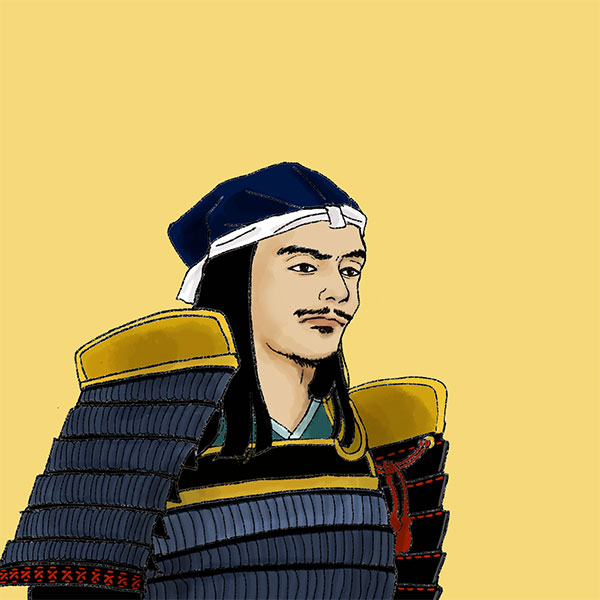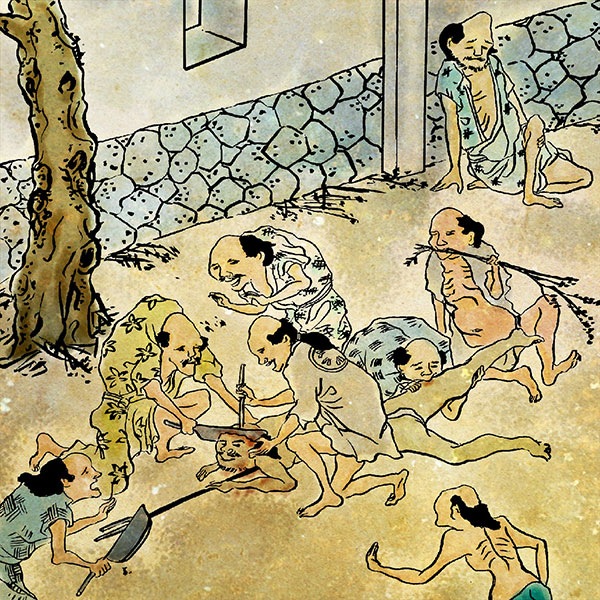Yoshikawa Tsuneie (1/2)The samurai who was mourned as a "pathetic loyalist"

Yoshikawa Tsuneie
- Article category
- biography
- name
- Tsuneie Yoshikawa (1547-1581)
- place of birth
- Tottori prefecture
- Related castles, temples and shrines

Tottori Castle
- related incident
In the latter part of the Sengoku period, Oda Nobunaga supported Ashikaga Yoshiaki and ruled the Kinai region.
After this, they turned their attention to the outside of Kinai. They ordered Hashiba Hideyoshi to attack the Chugoku region. Tottori Castle, which belonged to the Mori clan, was also targeted for attack. Yoshikawa Tsuneie was ordered to take refuge in the castle and take command. How did Tsuneie fight back at Tottori Castle? This time, we will look at Yoshikawa Tsuneie, a retainer of the Mori clan.
Iwami Yoshikawa family
The Yoshikawa family, which produced Tsuneie Yoshikawa. How did the Yoshikawa family take root in the Chugoku region?
The Yoshikawa family is said to have descended from the Fujiwara clan. During the Heian period, Fujiwara no Tsuneyoshi lived in Irie-sho Yoshikawa in Suruga Province, and hence the family name Yoshikawa.
During the Kamakura period, the Yoshikawa family served Minamoto no Yoritomo and achieved great success, for which they were given Fukui Manor in Harima Province (present-day Aboshi Ward, Himeji City, Hyogo Prefecture). During the Jokyu War, in which the Imperial Court fought against the regent Hojo clan led by Hojo Masako, they sided with the Hojo clan in Kamakura, and the Yoshikawa family was appointed as land steward of Oasa Manor in Yamagata County, Aki Province (present-day Oasa, Kitahiroshima Town, Hiroshima Prefecture). They settled in Aki Province around this time, and this was the beginning of the Aki Yoshikawa family, which would go on to become the main branch of the Yoshikawa family. In addition, branch lines of the Yoshikawa family were established in Harima and Suruga, which had been ruled until then. The Yoshikawa family of Yoshikawa Tsuneie was also a branch line, and the Iwami Yoshikawa family was established after they held the position of land steward of Iwami Tsubuchi Manor.
However, when the Northern and Southern Courts period began, the head family, the Aki Yoshikawa family, sided with the Northern Court, while the Iwami Yoshikawa family sided with the Southern Court. Furthermore, when Ashikaga Takauji rose to power and the Muromachi Shogunate was established, Takauji came into conflict with his younger brother, Ashikaga Tadayoshi. Again, the Yoshikawa family was in conflict, with the Aki Yoshikawa family siding with Ashikaga Takauji and the Iwami Yoshikawa family siding with Ashikaga Tadayoshi. The head family, the Aki Yoshikawa family, and the branch family, the Iwami Yoshikawa family, repeatedly sided with and separated from each other.
In the mid-Muromachi period and the beginning of the Sengoku period, the Aki Yoshikawa clan established a marriage relationship with the Mori clan, who were also kokujin (small local lords) of Aki Province. In particular, they married Myokyu, who would later become the wife of Mori Motonari, and Motonari's second son, Kikkawa Motoharu, was adopted into the Aki Yoshikawa clan. Kikkawa Tsuneyasu, head of the Iwami Yoshikawa clan, also served the Mori clan. Kikkawa Tsuneyasu achieved great success and was entrusted by the Mori clan with the management of Fukumitsu in Iwami Province and the Iwami Silver Mine.
Thus, Kikkawa Tsuneie was born as the son of Kikkawa Tsuneyasu, who became a vassal of the powerful Mori clan in the Chugoku region.
The Birth of Tsuneie Yoshikawa
Yoshikawa Tsuneie was born in Tenbun 16 (1547) as the eldest son of Yoshikawa Tsuneyasu, head of the Iwami Yoshikawa clan, and came of age in Eiroku 3 (1560).
In 1559, the year before Tsuneie came of age, the Mori clan attacked the Ogasawara clan in Iwami. Tsuneie's father, Kikkawa Tsuneyasu, distinguished himself in this battle and was given the land of Fukumitsu in Iwami. However, there was one man who was dissatisfied with the attack on the Ogasawara clan: Fukuya Takakane, a local lord of Iwami. As the Mori clan was victorious, they gave Fukuya Takakane some land, but the land that Fukuya had previously held was given to the Ogasawara clan, who had surrendered. Fukuya was dissatisfied with this reward based on merit.
In 1560, Fukuya Takakane left the Mori clan and joined the Amago clan of Izumo. He attacked the nearby Fukumitsu Castle of Yoshikawa Tsuneyasu. Yoshikawa Tsuneyasu intercepted the attack and repelled them by using matchlock guns, which were rare at the time. Yoshikawa Tsuneyasu also participated in the battle despite being young, and fought a major role.
The Mori clan, to which the Yoshikawa clan belonged, defeated the Amago clan of Izumo and became a feudal lord with a strong influence in the Chugoku region, from Kitakyushu in the west to Harima Province (present-day southwestern Hyogo Prefecture) in the east. In 1574, during the expansion of the Mori clan, Yoshikawa Tsuneyasu handed over the headship of the Iwami Yoshikawa clan to his eldest son, Tsuneie.
The conflict between the Mori and Oda clans
In 1567, the 11th year of the Eiroku era, the Mori clan defeated the Amago clan and expanded their territory from Kyushu to the west of the Kinai region. Oda Nobunaga of Owari Province (present-day western Aichi Prefecture) traveled to Kyoto accompanied by Ashikaga Yoshiaki. Ashikaga Yoshiaki became the 15th Shogun of the Muromachi Shogunate, and Oda Nobunaga, who had supported the Shogun, brought Kinai under his influence. After controlling the Kinai region from Tokai, he began his invasion of the Chugoku region. Oda Nobunaga ordered his vassal Hashiba Hideyoshi to invade Harima Province and then Inaba Province (present-day Tottori Prefecture).
In 1581, Hideyoshi Hashiba began his attack on Inaba Province. The lord of Tottori Castle, Toyokuni Yamana, belonged to the Mori clan. Toyokuni Yamana barricaded himself in the castle, and his retainers insisted on fighting to the end. However, Toyokuni Yamana, who was supposed to have supported the siege, escaped from the castle alone and surrendered to Hideyoshi Hashiba.
With Tottori Castle left without a lord, the Mori clan sent Ushio Motosada. However, Ushio Motosada was injured and was unable to lead. So they sent Kikkawa Tsuneie, a member of the Kikkawa clan, as the lord of Tottori Castle. At this time, Tsuneie went to Tottori Castle with a great deal of resolve, and it is said that he even brought a bucket with his own head with him when he joined the battle.
Siege of Tottori Castle
In February, Tsuneie Kikkawa entered Tottori Castle and immediately began construction of a defense line, preparing for a siege. However, Hideyoshi Hashiba ordered merchants from Wakasa Province to buy up all the rice in Tottori. Because he ordered them to do so at high prices, the soldiers in Tottori Castle even sold off their stockpiles of rice, so the stockpile in Tottori Castle only lasted about a month.
In June, Hideyoshi Hashiba invaded Tottori Castle with 20,000 soldiers and laid siege to it. Following the strategy of Kanbei Kuroda, he did not simply press forward with force, but instead cut off all communication between Tottori Castle and the outside world. The supply routes to the castle were cut off, and attempts to bring in food by land and sea failed. When food ran out, the people ate livestock and grass, and when that also ran out, people began to starve to death. The situation inside Tottori Castle was so bad that it was said that "the flesh of those who had died of starvation was cut up and eaten by each other. Children ate their parents, and younger brothers ate their older brothers."
Hashiba Hideyoshi's siege of Tottori Castle lasted for four months, but with no outside support, talks were held for surrender. Hashiba Hideyoshi praised Kikkawa Tsuneie's tenacity and suggested that the Yamana clan's retainers, who were in charge of Tottori Castle, take responsibility. Kikkawa Tsuneie disagreed and asked to commit suicide and have all the castle soldiers spared. Hideyoshi repeatedly tried to stop Kikkawa Tsuneie, but Tsuneie would not listen. Hideyoshi checked with Nobunaga in Azuchi, and Nobunaga decided that Tsuneie should commit suicide and all the castle soldiers should be spared.
The end of Keika
Tsuneie Kikkawa decided to commit suicide. The story of the moment of this suicide remains in detail. There was a man named Nagashige Yamagata among the retainers of the Aki Kikkawa clan (the head of the Kikkawa family, whose head was Motoharu Kikkawa).
- related incident

- WriterTomoyo Hazuki(Writer)I have loved history and geography since my student days, and have enjoyed visiting historical sites, temples and shrines, and researching ancient documents. He is especially strong in medieval Japanese history and European history in world history, and has read a wide range of things, including primary sources and historical entertainment novels. There are so many favorite military commanders and castles that I can't name them, but I especially like Hisashi Matsunaga and Mitsuhide Akechi, and when it comes to castles, I like Hikone Castle and Fushimi Castle. Once you start talking about the lives of warlords and the history of castles, there's a side of you that can't stop talking about them.




